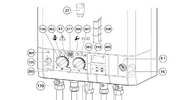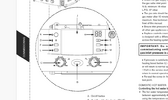Hello.
We have moved into a property that has a British Gas badged 532/i installed.
We had the boiler looked at before we moved in and he said the boiler was in good condition and seemed to be well maintained.
As it’s the summer we never used the heating however the hot water worked perfectly and the pressure never moved from 1bar for 3 months.
This past week I have been testing the heating and noticed a serious pressure issue. After bleeding all the radiators I pressured the system back up to 1bar and with the heating running the pressure went all the way up to 3.5. I checked the PRV to see minimal water coming out and when the system was switched off it fell to near 0. This cycle repeats if I add water to the system.
With the system at 0 I can run the heating and when operating it will go from 0 all the way up to near 2 bar. When operating in this way minimal water leaks out of the PRV and all radiators heat up.
I’ve had someone look and as expected he diagnosed the expansion vessel. He has re pressured the vessel but this doesn’t seem to have fixed as it’s still doing the exact same thing.
Is it worth replacing the vessell or at this point in the boilers life is it more cost effective to replace?
We have the budget to replace but would like to avoid if it’s not totally necessary.
Any input or further diagnoses welcome.
We have moved into a property that has a British Gas badged 532/i installed.
We had the boiler looked at before we moved in and he said the boiler was in good condition and seemed to be well maintained.
As it’s the summer we never used the heating however the hot water worked perfectly and the pressure never moved from 1bar for 3 months.
This past week I have been testing the heating and noticed a serious pressure issue. After bleeding all the radiators I pressured the system back up to 1bar and with the heating running the pressure went all the way up to 3.5. I checked the PRV to see minimal water coming out and when the system was switched off it fell to near 0. This cycle repeats if I add water to the system.
With the system at 0 I can run the heating and when operating it will go from 0 all the way up to near 2 bar. When operating in this way minimal water leaks out of the PRV and all radiators heat up.
I’ve had someone look and as expected he diagnosed the expansion vessel. He has re pressured the vessel but this doesn’t seem to have fixed as it’s still doing the exact same thing.
Is it worth replacing the vessell or at this point in the boilers life is it more cost effective to replace?
We have the budget to replace but would like to avoid if it’s not totally necessary.
Any input or further diagnoses welcome.




